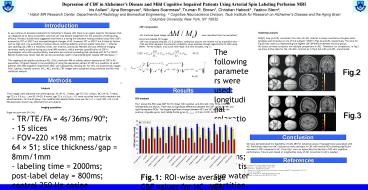Style A Square 42 - PowerPoint PPT Presentation
Title:
Style A Square 42
Description:
... Taub Institute for Research on Alzheimer s Disease and the Aging Brain ... (CBF) assessed by PET or SPECT and neuropathological changes of AD. – PowerPoint PPT presentation
Number of Views:53
Avg rating:3.0/5.0
Title: Style A Square 42
1
Depression of CBF in Alzheimer's Disease and Mild
Cognitive Impaired Patients Using Arterial Spin
Labeling Perfusion MRI Iris Asllani1, Ajna
Borogovac1, Nikolaos Scarmeas2, Truman R. Brown1,
Christian Habeck2 ,Yaakov Stern2, 1 Hatch MR
Research Center, Departments of Radiology and
Biomedical Engineering, 2 Cognitive Neuroscience
Division, Taub Institute for Research on
Alzheimers Disease and the Aging Brain Columbia
University, New York, NY 10032
Introduction
- CBF Computation
- ASL fractional signal images (?M / Mc) were
calculated from the normalized control and
labeled EPI images - CBF was computed using Eqs. 1 2 below,
taking into account the variable PLD by
acquisition slice 6,7 PGM and PWM represent the
posterior probability values obtained through
segmentation of SPRG using SPM99. For ROI
analysis, only voxels with PGM gt0.8 were
included, (Fig. 1).
As we continue to develop treatments for
Alzheimers disease (AD) there is an urgent need
for biomarkers that can diagnose AD as early as
possible, and that can map disease progression
for the purposes of testing drug efficacy.
Previous studies have suggested that there is a
strong link between resting cerebral blood flow
(CBF) assessed by PET or SPECT and
neuropathological changes of AD. However, PET or
SPECT are limited by factors such as high cost,
low availability, invasive nature, ionizing
radiation and low spatial resolution 1,2.Arterial
spin labeling (ASL) MRI is a relatively novel,
non-invasive, practically feasible and
cost-effective imaging technique (easily acquired
during structural MRI sessions), which provides
quantification of CBF in physiological units with
reproducibility, resolution and contrast
exceeding that obtained with PET or SPECT. Recent
studies have shown that ASL can be successfully
used in characterizing AD-related CBF decreases
3-5. This ongoing study applies continuous ASL
(CASL) perfusion MRI to reliably detect
depression of CBF in AD population. Of great
interest is the possibility of using the
depression pattern of CBF as a predictor of which
patients with Mild Cognitive Impairment (MCI)
will subsequently develop AD. For this, we
acquired ASL images from 3 groups, healthy
controls (HC), MCI, and AD CBF images were
compared using voxelwise and ROI-wise statistical
analysis.
Voxelwise analysis SPMT map (plt0.05,
corrected) from the (HC-AD) contrast is shown
overlaid on the glass-brain template and
slicewise on one of the subjects SPGR in Figs.2A
and 2B, respectively. The slice for Fig.2B was
chosen as representing the highest CBF difference
between the two groups. No voxels survived
correction for multiple comparisons in MCI.
Therefore, for comparison, in Fig.3 we show
similar data for the (HC-MCI) contrast as in
Fig.2 but with plt0.001, uncorrected.
The following parameters were used longitudinal
relaxation of blood, T1a 1400 ms blood/tissue
water partition, l 0.9 mL/g transit time, d
1300 ms labeling duration, t 2000 ms tissue
longitudinal relaxation in absence of RF, T1
1150 ms and 800 ms for GM and WM, respectively
T1 in presence of RF, T1rf 750 ms and 530 ms
for GM and WM, respectively 7 PLD adjusted to
account for the inter-slice acquisition time, w
(acquisition slice 1)(64 ms) 800 ms labeling
efficiency for CASL at 1.5T on Philips Intera, a
0.70. The equation is valid under the
assumption that t w gt d which holds true for
all our acquisitions.
Eq.1
Fig.2
Eq.2
Methods
- Subjects
- Flow images were obtained from three groups AD
(N12, 7 males, age 70.7 8.1 years), MCI (N10,
7 males, age 72.6 5.9 y.o.) , and HC (N20, 8
males, age 72.4 6.9 y.o.). HC were recruited
from family members and advertisements. For the
AD group, the modified Mini Mental State score
was 38.7 11.1 and CDR 1.25 0.45. IRB approved
consent was obtained from all subjects. - Imaging acquisition
- Single shot spin-echo EPI CASL
- TR/TE/FA 4s/36ms/90º
- 15 slices
- FOV220 198 mm matrix 64 51 slice
thickness/gap 8mm/1mm - labeling time 2000ms post-label delay
800ms control 250 Hz cosine modulation - position of labeling plane 48 mm inferior to
the center of the imaged volume - Alternating control/label images
- 3DT1 SPGR images
- TE/TR/FA 3 ms/34 ms/45º
- 100 slices
- FOV 240 240 mm matrix 256 256 slice
thickness/gap 1.5mm/1mm - Used for anatomical alignment to MNI template,
generation of tissue type probability masks and
ROI selection
Results
- ROI analysis
- Fig.1 shows the ROI-wise CBF for HC (blue), MCI
(yellow), and AD (red). Only ROIs in the left
hemispheres are shown. There was no significant
difference between the CBF values for left- and
right-hemisphere ROIs. The largest significant
change between MCI and HC was found in the
pulvinar, cingulate gyrus, and middle frontal
gyrus (ttwo_tailed gt2.0 at ?0.05, for all)
Fig.3
Conclusion
We have demonstrated the feasibility of CASL MRI
for detection areas of hypoperfusion associated
with AD. Preliminary data from MCI indicate an
early decrease in CBF with several ROIs showing
significant decrease in CBF compared to HC. From
Fig.1 one can appreciate the decline in CBF with
cognitive performance. Future work based on
longitudinal study of MCI conversion to AD is
needed.
References
- Scarmeas et al., Neuroimage 2335-45 (2004)
- Alavi et al., J Nucl Med 341681-1687 (1993)
- Asllani et al., JCBFM (AOP Oct 2007)
- Johnson et al. Preclinical prediction of
Alzheimer's disease using SPECT. Neurology
501563-1571 - Alsop et a., AD paper
- Alsop DC and Detre JA. Radiology 208410-416
(1998) - Wang et al., Magn Reson Med 48242-254 (2002)
Fig.1 ROI-wise average CBF values for HC, MCI,
and AD are shown in bleu, yellow, and red,
respectively. Only data from the left hemisphere
are shown. Data from the right hemisphere were
very similar. Bars represent s.d.































